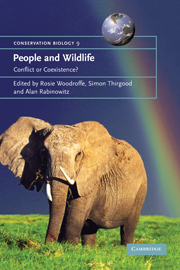Book contents
- Frontmatter
- Contents
- List of contributors
- Foreword
- Acknowledgements
- 1 The impact of human–wildlife conflict on natural systems
- 2 The impact of human–wildlife conflict on human lives and livelihoods
- 3 Characterization and prevention of attacks on humans
- 4 Non-lethal techniques for reducing depredation
- 5 Techniques to reduce crop loss: human and technical dimensions in Africa
- 6 Evaluating lethal control in the management of human–wildlife conflict
- 7 Bearing the costs of human–wildlife conflict: the challenges of compensation schemes
- 8 Increasing the value of wildlife through non-consumptive use? Deconstructing the myths of ecotourism and community-based tourism in the tropics
- 9 Does extractive use provide opportunities to offset conflicts between people and wildlife?
- 10 Zoning as a means of mitigating conflicts with large carnivores: principles and reality
- 11 From conflict to coexistence: a case study of geese and agriculture in Scotland
- 12 Hen harriers and red grouse: the ecology of a conflict
- 13 Understanding and resolving the black-tailed prairie dog conservation challenge
- 14 People and elephants in the Shimba Hills, Kenya
- 15 Safari hunting and conservation on communal land in southern Africa
- 16 Socio-ecological factors shaping local support for wildlife: crop-raiding by elephants and other wildlife in Africa
- 17 Jaguars and livestock: living with the world's third largest cat
- 18 People and predators in Laikipia District, Kenya
- 19 Searching for the coexistence recipe: a case study of conflicts between people and tigers in the Russian Far East
- 20 A tale of two countries: large carnivore depredation and compensation schemes in Sweden and Norway
- 21 Managing wolf–human conflict in the northwestern United States
- 22 Policies for reducing human–wildlife conflict: a Kenya case study
- 23 An ecology-based policy framework for human–tiger coexistence in India
- 24 The future of coexistence: resolving human–wildlife conflicts in a changing world
- References
- Index
11 - From conflict to coexistence: a case study of geese and agriculture in Scotland
Published online by Cambridge University Press: 23 November 2009
- Frontmatter
- Contents
- List of contributors
- Foreword
- Acknowledgements
- 1 The impact of human–wildlife conflict on natural systems
- 2 The impact of human–wildlife conflict on human lives and livelihoods
- 3 Characterization and prevention of attacks on humans
- 4 Non-lethal techniques for reducing depredation
- 5 Techniques to reduce crop loss: human and technical dimensions in Africa
- 6 Evaluating lethal control in the management of human–wildlife conflict
- 7 Bearing the costs of human–wildlife conflict: the challenges of compensation schemes
- 8 Increasing the value of wildlife through non-consumptive use? Deconstructing the myths of ecotourism and community-based tourism in the tropics
- 9 Does extractive use provide opportunities to offset conflicts between people and wildlife?
- 10 Zoning as a means of mitigating conflicts with large carnivores: principles and reality
- 11 From conflict to coexistence: a case study of geese and agriculture in Scotland
- 12 Hen harriers and red grouse: the ecology of a conflict
- 13 Understanding and resolving the black-tailed prairie dog conservation challenge
- 14 People and elephants in the Shimba Hills, Kenya
- 15 Safari hunting and conservation on communal land in southern Africa
- 16 Socio-ecological factors shaping local support for wildlife: crop-raiding by elephants and other wildlife in Africa
- 17 Jaguars and livestock: living with the world's third largest cat
- 18 People and predators in Laikipia District, Kenya
- 19 Searching for the coexistence recipe: a case study of conflicts between people and tigers in the Russian Far East
- 20 A tale of two countries: large carnivore depredation and compensation schemes in Sweden and Norway
- 21 Managing wolf–human conflict in the northwestern United States
- 22 Policies for reducing human–wildlife conflict: a Kenya case study
- 23 An ecology-based policy framework for human–tiger coexistence in India
- 24 The future of coexistence: resolving human–wildlife conflicts in a changing world
- References
- Index
Summary
INTRODUCTION: THE GOOSE–AGRICULTURE CONFLICT IN SCOTLAND, UK
Scotland hosts six species of geese for all or part of the year which comprise nine distinct breeding populations (Table 11.1). Six of these populations breed in arctic regions (Greenland, Iceland, Svalbard or Russia) and winter in Scotland, while the Scottish and naturalized populations of greylag geese (Anser anser) and Canada geese (Branta canadensis) are resident. Many populations are protected under the 1979 European Union Birds Directive (Directive 79/409/EEC) and the 1981 Wildlife and Countryside Act in the UK. Greenland white-fronted geese (Anser albifrons flavirostris) and both populations of barnacle geese (Branta leucopsis) are afforded the highest level of protection under Annex I of the EU Directive, while bean geese (Anser fabalis), greylag geese, Canada geese, pink-footed geese (Anser brachyrhynchus) and white-fronted geese are listed under Annex II/2 and may be legally hunted in the UK.
Most populations are increasing, largely as a result of hunting controls (Owen 1990). However, their ranges in Scotland remain very restricted in time and space (Fig. 11.1, Table 11.1). The entire Svalbard barnacle goose population, for example, winters in a 50 × 5 km coastal strip on the Solway Firth, in southwest Scotland (Fig. 11.1). Similarly, even highly mobile species like the pink-footed goose, with a winter range extending from northeast Scotland to southeast England, remains concentrated around a few important roost sites.
- Type
- Chapter
- Information
- People and Wildlife, Conflict or Co-existence? , pp. 176 - 191Publisher: Cambridge University PressPrint publication year: 2005
- 8
- Cited by



